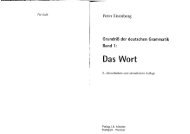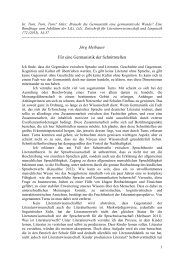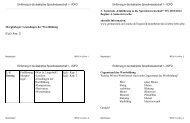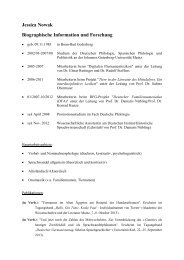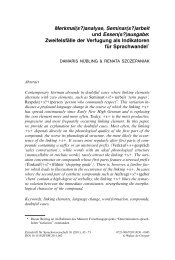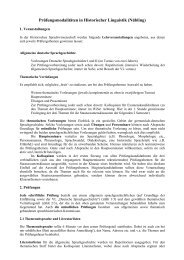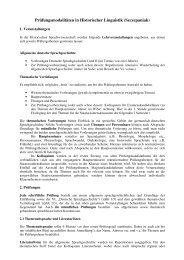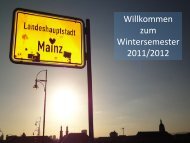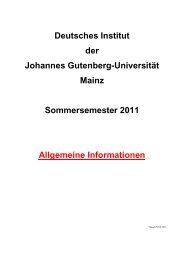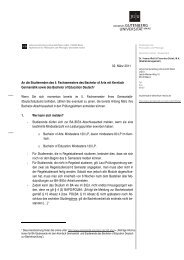Presentation
Presentation
Presentation
Create successful ePaper yourself
Turn your PDF publications into a flip-book with our unique Google optimized e-Paper software.
Nonmanual markings for topic<br />
constructions in Hong Kong<br />
Sign Language<br />
Felix Sze<br />
Centre for Sign Linguistics and Deaf<br />
Studies<br />
Chinese University of Hong Kong
Previous studies in sign languages<br />
• General observations:<br />
• Topics or topicalized constituents are marked<br />
non-manually in sign languages:<br />
• ASL:<br />
• Fischer (1974, 1975), Liddell (1980), McIntire<br />
(1980), Baker and Cokely (1980), Padden<br />
(1988), Isenhath (1990),Janzen (1995, 1997,<br />
1999), Aarons (1996), Valli and Lucas (2000),<br />
among others
Previous studies in sign<br />
languages<br />
• Other sign languages:<br />
• SLN (NGT):<br />
• Coerts (1992): topicalized elements are marked by<br />
brow raise.<br />
• ISL:<br />
• Rosenstein (2000): topics are followed by blinks,<br />
change of eye gaze, change in head or body position<br />
• AUSLAN:<br />
• Johnston & Schembri (2007): topics are marked by<br />
brow raise, head tilt and followed by a pause<br />
• BSL:<br />
• Sutton-Spence & Woll (1999): topics are marked by<br />
widened eyes, head nod and followed by a pause
Previous studies in sign<br />
languages<br />
• Some inconsistent findings even within the<br />
same sign language in the following three<br />
areas:<br />
1. The kinds of syntactic constituents referred<br />
to by the term ‘topic’/’topicalization’<br />
2. The nonmanual features used to mark<br />
these elements<br />
3. The grammatical functions served by these<br />
non-manually marked elements
Table 1: The types of<br />
constituents referred to<br />
by ‘topic/topicalization’ in<br />
different studies<br />
Fronted<br />
constituents<br />
(may have<br />
undergone<br />
syntactic<br />
movement)<br />
Non-fronted<br />
sentence-initial<br />
constituents<br />
(hanging, basegenerated<br />
topic/adverbials)<br />
Non-fronted,<br />
nonsentenceinitial<br />
constituents<br />
ASL<br />
Fischer(1974, 1975), Liddell<br />
(1980), Padden (1987),<br />
Valli and Lucas (2000)<br />
*<br />
McIntire (1980)<br />
*<br />
Baker and Cokely (1980)<br />
*<br />
*<br />
Aarons (1996)<br />
* ( marking 1)<br />
*(marking 2 / 3)<br />
Janzen (1995, 1997, 1999)<br />
*<br />
*<br />
*<br />
Other<br />
SLs<br />
Rosenstein (2001)(ISL)<br />
Johnston & Schembri<br />
(2007)(Auslan)<br />
*<br />
*<br />
*<br />
Sutton-Spence & Woll<br />
(1999)(BSL)<br />
*<br />
*<br />
Coerts (1992)(SLN)<br />
*<br />
*<br />
*
Table 2: non-manuals of ‘topic/topicalized’ constituents in different SLs
Table 3: what are the functions served by the constituents<br />
marked by the non-manuals?
How to interpret the inconsistent<br />
findings in previous studies in SLs?<br />
• Terminological/definitional confusions in both spoken<br />
and signed language literature:<br />
• Whether topic also encodes discourse-new<br />
information<br />
• Whether ‘topicalization’ is a fronting process<br />
that marks a constituent as ‘the topic’ or ‘focus’<br />
(i.e. focalization); other functions?<br />
• Whether topic must come first in a sentence<br />
• Possible that certain non-manuals are more central<br />
than others brow raise as most frequently reported
How to interpret the inconsistent<br />
findings in previous studies in SLs?<br />
• Possible that certain non-manuals, such<br />
as brow raise, can indeed serve a wide<br />
range of functions in the information<br />
structure in sign languages<br />
• Findings in BSL and ISL possibility of<br />
cross-linguistic variations
Purpose of the current study<br />
• Find out<br />
1. Do topic constructions exist in the<br />
spontaneous data of HKSL? If so,<br />
what kinds of ‘topic’ are they?<br />
2. Are these topic constructions<br />
marked consistently by non-manual<br />
features?
Types of constructions to be<br />
investigated in this study<br />
Three major types of constructions<br />
• ‘Aboutness’ topics<br />
• ‘Scene-setting’ topics<br />
• Fronted grammatical objects
‘Aboutness’ topics<br />
(1) Aboutness topic:<br />
• Reinhart (1981) and Gundel (1985, 1988a,<br />
1988b)<br />
• Defined in terms of pragmatic aboutness:<br />
represent what the sentence is about.<br />
• Represent familiar and identifiable<br />
information<br />
• Can be shifted or continued<br />
• Not necessarily sentence-initial
‘Aboutness’ topics<br />
• Aboutness topics:<br />
• Most often realized as grammatical subject<br />
(default)<br />
• May also be realized as<br />
• In-situ grammatical object<br />
• clause-external, sentence-initial<br />
constituents:<br />
• hanging topic<br />
• left dislocation<br />
• fronted grammatical object
‘Aboutness’ topics<br />
• Grammtical subject and in-situ grammatical object:<br />
• Felix is an obnoxious guy. Even Matilda can’t stand<br />
him. (Reinhart 1981:63)(subject and object)<br />
• Hanging topic:<br />
• My work, I’m going crazy. (Bland, 1980)<br />
• Left dislocation:<br />
• Marcos, he resigned. (Gundel 1988:210 universal<br />
paper)<br />
• Fronted grammatical object:<br />
• Him I can’t understand (Gundel 1988)
‘Scene-setting’ topics<br />
(2) Scene-setting topic (Chafe, 1976)<br />
• provides a spatial, temporal or individual framework within<br />
which the main predication holds.<br />
• Mostly clause-external<br />
• Include:<br />
(a) Chinese-styled topics<br />
Shang ci jiaoyou, haizimen dou lei ji le<br />
last CL outing children all tired extremely CRS<br />
‘On the last outing, the children were all exhausted.’<br />
(Chen 1996:398)
‘Scene-setting’ topics<br />
(b) Sentence-initial locative/temporal adverbial<br />
phrases:<br />
• In meinem Traum war Peter ein Krokodil<br />
“In my dream, Peter was a crocodile.”<br />
(Jacobs 2001:657)<br />
(c) Sentence-initial locative/temporal adverbial<br />
clauses:<br />
• (John was very busy that morning.) After the children<br />
went to school, he had to clean the house and go<br />
shopping for the party. (Lambrecht 1994:121)
Fronted grammatical objects<br />
(3) Fronted grammatical objects<br />
• Fronted grammatical objects that do not<br />
code the aboutness topic<br />
• What discourse functions do they serve?<br />
• Are these functions marked non-manually?
Methodology: data collection<br />
• Spontaneous discourse data:<br />
• 4 native signers of HKSL, all in their twenties<br />
• Conversation data:<br />
• 1 hr 56 mins of paired unstructured<br />
conversations<br />
• Monologue data:<br />
• 39 mins of picture-elicited narratives<br />
• 51 mins of answers to questions
Methodology: Data transcription<br />
and coding<br />
• Data transcriptions:<br />
• First by author of this study<br />
• Confirmed by the native informants<br />
• Sentence-delimitation by native informants<br />
• Identification of different types of topics<br />
(Appendix)
Types of non-manuals coded in<br />
the data<br />
1. Brow raise<br />
2. Specific head position<br />
3. Indicators of potential intonational break:<br />
• Followed by a blink<br />
• Followed by a pause (0.3 sec or above)<br />
• The last sign of the target constituent is<br />
held for 3 frames (0.12 sec) or longer<br />
upon the completion of movement.
Methodology
Findings: aboutness topics
Findings: Aboutness topics<br />
(1) Aboutness topics:<br />
• 2346 instances of overt ‘aboutness’ topics<br />
• realized syntactically as<br />
• grammatical subjects (2142, 81%)<br />
• in-situ grammatical objects (40, 1.7%)<br />
• hanging topic (104, 4.4%)<br />
• left dislocation (19, 0.8%)<br />
• Sentence-initial grammatical objects (41, 1.7%)<br />
• OSV (24, 1%)<br />
• Hanging topics, left dislocation and O in OSV clauseexternal<br />
syntactic position more likely to be<br />
intonationally separated from the rest of the sentence
Table 4: non-manual features associated with ‘aboutness’ topics<br />
Types of non-manuals<br />
Hanging<br />
topics (104)<br />
Left dislocated<br />
constituents (19)<br />
Fronted<br />
objects as<br />
topics (24)<br />
Brow raise<br />
4 (3.9%)<br />
1 (5.3%)<br />
3 (12.5%)<br />
Specific head position<br />
9 (8.7%)<br />
1 (5.3%)<br />
6 (25%)<br />
Intonational<br />
break<br />
following the<br />
topic<br />
constituent<br />
Followed by a<br />
blink<br />
Noticeable<br />
pause (0.3 sec<br />
or longer)<br />
19 (18.3%)<br />
14 (13.5%)<br />
(from 0.3 to<br />
1.1 sec)<br />
2 (10.5%)<br />
4 (21.1%)<br />
(from 0.3 to<br />
0.62 sec)<br />
10 (41.7%)<br />
3 (12.5%)<br />
(from 0.3 to<br />
0.94 sec)<br />
Lengthening of<br />
the last sign (3<br />
video<br />
frame/0.12 sec<br />
or longer)<br />
16 (15.4%)<br />
(3 to 8<br />
frames, 0.12<br />
to 0.32 sec)<br />
4 (21.1%)<br />
(3 to 9 frames,<br />
0.12 to 0.36<br />
sec)<br />
3 (12.5%)<br />
(4 to 5<br />
frames, 0.16<br />
to 0.2 sec)<br />
• % of brow raise/specific head position: very low<br />
• % of features signaling an intonational break: very low
Findings: Aboutness topics<br />
Example 1 (hanging topic):<br />
[IX-deaf-allowance DEAF DEAF-ALLOWANCE IX-deafallowance<br />
] MONEY (hesitation) MONEY EVERY MONTH<br />
HAVE<br />
‘About the deaf allowance, (I) get the money every month.’<br />
•last sign of hanging topic being held for 3 frames<br />
Example 2 (Left dislocation):<br />
IX-kenny ALL (SAY) IX-kenny STRONG.<br />
‘He (kenny), all of them (say) he is strong.’<br />
•No specific non-manual marking
Findings: Aboutness topics<br />
Example 3 (fronted topic object):<br />
INTERPRETER^SIGN-LANGUAGE GOVERNMENT<br />
PAY-THEM NOT-HAVE<br />
‘The SL interpreters, the government does not pay<br />
(them).’<br />
• no particular non-manuals
Findings: Aboutness topics<br />
• A small % (i.e. 8 tokens) of aboutness topic: marked<br />
by brow raise.<br />
• How can we explain these data?<br />
• Two possible types:<br />
• When the NP consists of several signs and the<br />
referent represents identifiable information but not<br />
fully activated information<br />
• Involve contrastive contexts
Findings: Scene-setting topics
Findings: scene-setting topics<br />
• Four types of potential scene-setting topics are<br />
identified in the data:<br />
1. Conventional temporal adverbials<br />
• PAST, NOW, MONDAY, MORNING<br />
2. NPs that set up temporal domains<br />
• SECONDARY-ONE when I was studying secondary<br />
one (=grade 7)<br />
• FIRST-ROUND in the first round of the competition<br />
• ONE-SEMESTER in one semester
Findings: scene-setting topics<br />
3. Subordinate clauses that set up a temporal<br />
domain<br />
• GET-MARRIED FINISH, MINDLESS DON’T<br />
• ‘After getting married, (one) shouldn’t be lousy<br />
(about appearance)’<br />
4. Locative expression<br />
• HILL IX-up HAVE THREE<br />
• On the hill were three (persons)”
Table 5: non-manuals accompanying scene-setting topics<br />
Conventional<br />
temp adverbials<br />
(116)<br />
NPs that set up<br />
temporal<br />
domains (18)<br />
Scene-setting<br />
subordinate<br />
clauses (73)<br />
Locative<br />
expressions (10)<br />
Types of<br />
non-manuals<br />
Initial (<br />
82<br />
)<br />
Non-Initial(<br />
34<br />
subtotal<br />
Initial (<br />
Brow raise<br />
32<br />
39%<br />
8<br />
24%<br />
40<br />
34%<br />
11<br />
73%<br />
3<br />
100%<br />
14<br />
78%<br />
54<br />
76%<br />
1<br />
50%<br />
55<br />
75%<br />
8<br />
89%<br />
0<br />
0%<br />
8<br />
80%<br />
Specific head<br />
position<br />
27<br />
33%<br />
9<br />
26%<br />
36<br />
31%<br />
8<br />
53%<br />
3<br />
100%<br />
11<br />
61%<br />
51<br />
72%<br />
1<br />
50%<br />
53<br />
73%<br />
5<br />
56%<br />
1<br />
100%<br />
6<br />
60%<br />
blink<br />
pause<br />
hold<br />
31<br />
38%<br />
11<br />
13%<br />
16<br />
20%<br />
)<br />
15<br />
)<br />
Non-Initial(<br />
3<br />
subtotal<br />
Initial (<br />
3<br />
9%<br />
0<br />
0%<br />
0<br />
0%<br />
34<br />
29%<br />
11<br />
9%<br />
16<br />
14%<br />
8<br />
53%<br />
4<br />
27%<br />
8<br />
53%<br />
)<br />
71<br />
)<br />
Non-Initial(<br />
2<br />
subtotal<br />
Initial (<br />
1<br />
33%<br />
1<br />
33%<br />
1<br />
33%<br />
9<br />
50%<br />
5<br />
28%<br />
9<br />
50%<br />
38<br />
54%<br />
12<br />
17%<br />
23<br />
32%<br />
)<br />
9<br />
)<br />
Non-Initial(<br />
1<br />
subtotal<br />
Intonation break<br />
2<br />
100%<br />
0<br />
0%<br />
1<br />
50%<br />
40<br />
55%<br />
12<br />
16%<br />
24<br />
33%<br />
7<br />
78%<br />
5<br />
56%<br />
2<br />
22%<br />
)<br />
0<br />
0.<br />
0<br />
0%<br />
0<br />
0%<br />
7<br />
70%<br />
5<br />
50%<br />
2<br />
20%
Table 6: types of head positions with scene-setting topics<br />
Types of head positions accompanying scenesetting<br />
topics<br />
1. Head tilting sideward<br />
2. Face turning sideward<br />
3. A neutral head position<br />
(which is changed after the topic)<br />
4. Head nod<br />
- accompanies the scene-setting topic if the latter is<br />
short.<br />
- Occurs towards the end of the scene-setting topic if<br />
the latter consists of several words<br />
5. Head tilting backward<br />
6. Head tilting forward / head + body leaning<br />
forward<br />
No. of<br />
tokens<br />
1<br />
2<br />
4<br />
6<br />
9<br />
82<br />
%<br />
1.0%<br />
1.9%<br />
3.8%<br />
5.8%<br />
8.7%<br />
78.8%
• Primary non-manual markers of scene-setting topics:<br />
• Brow raise<br />
Always together?<br />
• Specific head positions Can occur independently?<br />
Table 7: occurrence of brow raise and head positions with scene-setting topics<br />
Types of non-manuals<br />
Conventional<br />
temporal<br />
adverbials<br />
(116)<br />
NPs that set<br />
up temporal<br />
domains (18)<br />
Scenesetting<br />
subordinate<br />
clauses (73)<br />
Locative<br />
expressions<br />
(10)<br />
♦ Specific head position<br />
♦ NO brow raise<br />
10 (8.6%)<br />
0 (0%)<br />
7 (9.6%)<br />
2 (20%)<br />
♦ Specific head position<br />
♦ brow raise<br />
26 (22.4%) c<br />
11 (61.1%)<br />
45 (61.6%)<br />
8 (80%)<br />
♦ NO specific head position<br />
♦ brow raise<br />
16 (13.8%)<br />
3 (16.7%)<br />
12 (16.4%)<br />
0 (0%)<br />
subtotal:<br />
52 (44.8%)<br />
c<br />
14 (77.8%)<br />
64 (87.7%)<br />
10 (100%)<br />
♦ NO specific head position<br />
♦ NO brow raise<br />
64 (55.2%)<br />
4 (22%)<br />
9 (12.3%)<br />
0 (0%)
Findings: scene-setting topics<br />
Example 4 (Conventional temporal adverbial):<br />
NEXT SATURDAY IX-group-B OTHER B IX-group-B<br />
‘Next Saturday, group B (had the competitons).’<br />
•forward head tilt + brow raise<br />
Example 5 (NP that sets up a temporal domain):<br />
SECONDARY-TWO, START PLAY-BASKETBALL, HAVE-<br />
COMPETION, FARE-BETTER THAN<br />
‘At secondary two (=grade8), I started playing basketball and<br />
had competitions; I was better than (other senior schoolmates).’<br />
•forward tilt + brow raise
Findings: scene-setting topics<br />
Example 6 (Scene-setting subordinate clause):<br />
IX-1 SECONDARY-FIVE GRADUATE IX-1 FINISH, gesture CLa-big-pile-of-books<br />
BOOK gesture DICTIONARY MANY<br />
ENGLISH DICTIONARY gesture IX-1 gesture CL-a-big-pile-ofbooks<br />
gesture<br />
‘After I graduated from secondary-five (=grade 11), I had a big pile<br />
of used books such as English books and dictionary; I didn’t know<br />
what to do with them.”<br />
•backward head tilt + brow raise<br />
Example 7 (locative):<br />
IX-here HAVE TWO, FATHER IX-father OLD YOUNG NOT OLD,<br />
IX-boy BOY<br />
‘In this place, there are two persons – a father, who is quite old,<br />
not young, and a boy.’<br />
•forward head tilt + brow raise
Findings: scene-setting topics<br />
• Scene-setting topics in HKSL are primarily marked with<br />
brow raise and specific head positions.<br />
• Why some temporal adverbials are not marked with<br />
these non-manuals?<br />
• Not all of them serve a scene-setting function.<br />
• English (Le Draoulec & Péry-Woodley 2001)<br />
• sentence-initial adverbials scene-setting role<br />
outside the proposition<br />
• sentence-final adverbials just modifying the<br />
proposition.<br />
• HKSL: this functional difference hinges upon the<br />
presence of non-manuals.
Findings: Scene-setting topics<br />
• Scene-setting topics, whether they are<br />
sentence-initial or not, can be marked by brow<br />
raise and specific head positions.<br />
• These two non-manuals<br />
• not tied to a particular syntactic position<br />
• pragmatic function marker
Fronted non-topic grammatical<br />
objects
Findings: fronted non-topic grammatical objects<br />
• In HKSL, a grammatical object may be<br />
fronted if it is the ‘aboutness’ topic no<br />
specific non-manual marking<br />
• 59 instances of fronted non-topic<br />
grammatical objects 4 major types
Findings: fronted non-topic grammatical objects<br />
Table 8: types of fronted non-topic grammatical objects<br />
1. it is salient in discourse and is spatially modified (i.e.<br />
pronominal/determiner)<br />
2. it is contrastive<br />
5<br />
6<br />
3. it is a part of the proposition being negated in the<br />
sentence<br />
4. the sentence involves transitive plain verbs that<br />
favour verb-final constructions in general, e.g.<br />
DISLIKE, DETEST, BE-INTERESTED-IN, HAVE-<br />
POWER-IN<br />
4<br />
44
Table 9: non-manuals with fronted non-topic objects<br />
Brow raise<br />
Specific head position<br />
Intonation<br />
break<br />
following<br />
the fronted<br />
non-topic<br />
object<br />
Blink<br />
Pause<br />
hold<br />
Fronted non-topic grammaticalal objects: 59<br />
Salient<br />
referents<br />
with spatial<br />
markings<br />
5<br />
0<br />
0<br />
2<br />
(40%)<br />
1<br />
(20%)<br />
2<br />
(40%)<br />
Involve plain<br />
verbs that<br />
favour verbfinal<br />
constructions<br />
44<br />
13<br />
(29.5%)<br />
15<br />
(34.1%)<br />
14<br />
(31.8%)<br />
4<br />
(9.1%)<br />
1<br />
(2.3%)<br />
Involve<br />
contrastive<br />
context<br />
6<br />
0<br />
(0%)<br />
4<br />
(66.7%)<br />
1<br />
(16.7%)<br />
0<br />
0<br />
Involve<br />
negation<br />
/negative<br />
modal<br />
4<br />
2<br />
(50%)<br />
2<br />
(50%)<br />
3<br />
(75%)<br />
1<br />
(25%)<br />
0
Findings: Fronted non-topic grammatical objects<br />
• Highest % of occurrence:<br />
• Specific head positions that accompany contrastive<br />
fronted objects<br />
• Blinks following a fronted constituent<br />
• Brow raise only in :<br />
• negated sentences<br />
• Sentences with verbs that favour verb-final word<br />
order all 13 tokens of such verbs are negative in<br />
meaning, e.g. DISLIKE, DETEST, BE-IGNORANT,<br />
etc
Findings: Fronted non-topic grammatical objects<br />
• Similarly, specific head positions that mark fronted<br />
objects in verb-final transitive constructions all 15<br />
tokens involve verbs negative in meaning.<br />
• This skewed pattern:<br />
• Brow raise and specific head positions do not<br />
mark fronted object constituents per se.<br />
• Serve the purpose of contrast/focus.
Findings: Fronted non-topic grammatical objects<br />
Example 8 (contrastive context):<br />
BASKETBALL, IX-1 ENROLL-IN STILL<br />
‘The basketball (competition), I still enroll in (it)’<br />
• no non-manuals<br />
Example 9 (negative verb that faour verb final construction):<br />
LOUSY IX-1 DISLIKE<br />
‘Lousy (handwriting), I don’t like (it)’.<br />
• barely noticeable forward head tilt
General Discussion<br />
• Aboutness topics: no specific non-manual features.<br />
• Scene-setting topics: primarily marked by brow raise<br />
and/or specific head position, most likely forward tilt/lean.<br />
• Fronted non-topic grammatical objects: no nonmanual<br />
markers;<br />
• but brow raise and specific head positions can be<br />
seen if<br />
• the sentence is negated or involve a verb with a<br />
negative meaning;<br />
• the fronted constituent is contrastive.<br />
• Brow raise and specific head positions in HKSL:<br />
• Mark scene-setting topics<br />
• Mark contrast/focus??
• Negated sentences marked by brow raise and<br />
head tilt?<br />
• Preliminary supportive evidence:<br />
• 23 instances of NOT in 40 minutes of free<br />
conversation by 4 native signers<br />
• 19 out of 23: brow raise (83%)<br />
• 14 out of 23: forward head tilt/forward<br />
head+ body lean (61%)<br />
• In ASL and NGT, body leans may signal<br />
focus/contrast (Wilbur and Patschke 1998, Kooij,<br />
Crasborn and Emmerik, 2006)<br />
Further<br />
research in<br />
HKSL<br />
NEEDED!<br />
• Eyebrow raising in spoken English dialogues <br />
aligned with pitch accents that may signal<br />
emphasis (Flecha-Garcia 2004)
References<br />
• Aarons, Debra. 1996. Topics and Topicalization in American<br />
Sign Language. Stellenbosch Papers in Linguistics 26, pp.65-<br />
106. University of Stellenbosch: South Africa.<br />
• Baker, Charlotte & Dennis Cokely. 1980. American Sign<br />
Language: A teacher's resource text on grammar and culture.<br />
Silver Spring, MD: TJ Publishers.<br />
• Bland, S.R.K. 1980. Topic/Comment sentences in English.<br />
Cornell Working Papers in Linguistics. 2:32-49.<br />
• Chafe, Wallace. 1976. Giveness, contrastiveness, definiteness,<br />
subjects, topics, and point of view. In: Charles Li, ed. Subject<br />
and Topic. New York: Academic Press, pp.25-55.<br />
• Chen, Ping . 1996. Pragmatic interpretation of structural topics<br />
and relativization in Chinese. Journal of Pragmatics 26, pp.389-<br />
406.<br />
• Coerts, Janes. 1992. Nonmanual Grammatical Markers: An<br />
Analysis of Interrogatives, Negations and Topicalizations in<br />
Sign Language of the Netherlands. PhD dissertation. University<br />
of Amsterdam, Amsterdam.
Fischer, Susan. 1974. Sign Language and Linguistic Universals. In:<br />
Nicolas Ruwet and Christian Rohrer, eds. Actes du Colloque<br />
Franco-Allemand De Grammaire Transformationale, Band II: Étude<br />
De Semantiques et Autres. Tübingen: Niemeyer, pp.187–204.<br />
Fischer, Susan. 1975. Influences on Word Order Change in<br />
American Sign Language. In: Charles Li, ed. Word Order and Word<br />
Order Change. Austin TX: University of Texas Press, pp.3–25.<br />
Flecha-Garcia, Maria. 2004. Eyebrow raising in dialogue: discourse<br />
structure, utterance function, and pitch accents. Ph.D dissertation.<br />
University of Edinburgh.<br />
Frascarelli, Mara. (2000) The Syntax-Phonology Interface in Focus<br />
and Topic Constructions in Italian. The Netherlands: Kluwer<br />
Academic Publishers.<br />
Gundel, Jeanette. 1985. ‘Shared knowledge’ and topicality. Journal<br />
of Pragmatics. 9, pp.83-107.<br />
Gundel, Jeanette. 1988a. The role of topic and comment in linguistic<br />
theory. NewYork & London: Garland Publishing, Inc.<br />
Gundel, Jeanette. 1988b. Universals of topic-comment structure. In:<br />
Michael Hammond, Edith Moravcsik & Jessica Wirth, eds. Studies<br />
in Syntactic Typology. Amsterdam: John Benjamins, pp.209-239.
• Isenhath, John. 1990. The Linguistics of American Sign<br />
Language. McFarland & Co., Inc., Jefferson, NC.<br />
• Jacobs, Joachim. 2001. The dimensions of topic-comment.<br />
Linguistics 39(4), pp.641-681.<br />
• Janzen, Terry. 1995. Differentiating topic from subjects in ASL.<br />
In: Marie-Christine Aubin, ed. Perspectives d’ avenir en<br />
traduction. Winnipeg, Presses Universitaires de Saint-Boniface,<br />
pp.57-74.<br />
• Janzen, Terry. 1997. Pragmatic and syntactic features of topics<br />
in American Sign Language. Meta. Numéro special:<br />
L'interprétation en langues des signes, 42(3), pp.502-514.<br />
• Janzen, Terry. 1999. The grammaticalization of topics in<br />
American Sign Language. Studies in Language, 23(2), pp.271-<br />
306<br />
• Johnston, Trevor & Adam Schembri. 2007. Australian Sign<br />
Language: an introduction to sign language linguistics. New<br />
York: Cambridge University Press.<br />
• Kooij, E. van der, Crasborn, O.A. & Emmerik, W. 2006.<br />
Explaining prosodic body leans in Sign Language of the<br />
Netherlands: pragmatics required. Journal of Pragmatics, 38,<br />
1598-1614.
• Lambrecht, Knud. 1994. Information Structure and Sentence<br />
Form: Topic, focus, and the mental representation of discourse<br />
referents. New York: Cambridge University Press.<br />
• Liddell, Scott. 1980. American Sign Language Syntax. The<br />
Hague: Mouton<br />
• McIntire, Marina. 1980. Locatives in American Sign Language.<br />
Unpublished Ph.D dissertation, University of California.<br />
• Padden, Carol. 1983/1988. Interaction of morphology and<br />
syntax in American Sign Language. Ph.D. Dissertation,<br />
University of California, San Diego. (Published as Outstanding<br />
dissertations in Linguistics, Garland Series. New York, London:<br />
Garland Publishing, Inc.)<br />
• Reinhart, Tanya. 1981. Pragmatics and linguistics: an analysis<br />
of sentence topics. Philosophica, 27(1) (Special issue on<br />
Pragmatic Theory), pp.53-93.<br />
• Rosenstein, Ofra. 2001. Israeli Sign Language – a topic<br />
prominent language. MA thesis, Haifa University.<br />
• Sutton-Spence, Rachel & Bencie Woll. 1999. The Linguistics of<br />
British Sign Language. Cambridge: Cambridge University Press.<br />
• Wilbur R.B. & Patschke, C. 1998. Body Leans and marking<br />
contrast in ASL. J. Pragmatics 30: 275-303.
Appendix: Data transcription and<br />
coding<br />
• Reinhart’s procedure of identifying aboutness topics:<br />
• (I) First, select an NP whose referent is already in the<br />
context set unless:<br />
• (a) the sentence is linked to the previous sentence by<br />
a semantic connector that indicates a turn in the<br />
discourse content.<br />
• e.g. …(A did so and so). At the same time, …(B did<br />
so and so)<br />
• (b) the sentence starts a new segment of the context<br />
set. (i.e. an entirely new discourse topic irrelevant to<br />
the previous one)
Appendix: Data transcription<br />
and coding<br />
• In both situations (a) and (b): the topic any definite<br />
NP which represents an entity familiar, as well as<br />
identifiable to the addressee.<br />
• The selected NP represents a shifted topic<br />
• This NP does not need to be referentially linked to the<br />
previous discourse.<br />
• The above procedure (Reinhart 1981) is used to<br />
identify aboutness topics in the data.
Appendix: Data transcription<br />
and coding<br />
• Steps of identifying ‘aboutness’ topics and ‘scene-setting’ topics<br />
in the HKSL data:<br />
• In a new segment of discourse,<br />
• if there is a clause external definite NP that represents what<br />
the that sentence and what the next sentence is about <br />
selected as the aboutness topic<br />
• If there is no clause external NP, and if the subject is definite<br />
the subject is coded as aboutness topic<br />
• If the sentence introduces a new referent into the discourse<br />
presentational sentence no aboutness topic.
Appendix: Data transcription<br />
and coding<br />
• For other non-discourse-initial sentences:<br />
• Aboutness topic any definite NP referentially linked<br />
to the previous sentence (continued topic)<br />
• If both subjects and objects are definite NPs linked to<br />
the previous discourse subject as the aboutness<br />
topic<br />
• A definite object can only be an aboutness topic if the<br />
subject is indefinite.<br />
• Aboutness topics and be null or overt, shifted or<br />
continued
Appendix: Data transcription<br />
and coding<br />
• Sentence-initial temporal phrases, locative adverbials and<br />
subordinate clauses scene-setting topics unless they<br />
also represent what the sentence is about.<br />
• Certain types of sentences are assumed to be topic-less:<br />
identificational, presentational and event-reporting<br />
sentences.<br />
• Fronted grammatical objects (i.e. OSV) which are not the<br />
aboutness topics are coded separately<br />
• OV clauses with a null subject are excluded (as SOV is<br />
also a permissible order in HKSL)<br />
• The verbs in these OSV sentences must also allow SVO<br />
orders (supported by evidence of SVO of the same verbs<br />
in the same database)



